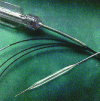ABC of interventional cardiology: percutaneous coronary intervention. I: history and development
- PMID: 12750213
- PMCID: PMC1125993
- DOI: 10.1136/bmj.326.7398.1080
ABC of interventional cardiology: percutaneous coronary intervention. I: history and development
Figures














References
-
- Gruentzig AR. Transluminal dilatation of coronary artery stenosis. Lancet 1978;1: 263. - PubMed
-
- Smith SC Jr, Dove JT, Jacobs AK, Kennedy JW, Kereiakes D, Kern MJ, et al. ACC/AHA guidelines of percutaneous coronary interventions (revision of the 1993 PTCA guidelines)-executive summary. A report of the American College of Cardiology/American Heart Association Task Force on Practice Guidelines (committee to revise the 1993 guidelines for percutaneous transluminal coronary angioplasty). J Am Coll Cardiol 2001;37: 2215-39 - PubMed
-
- Meyer BJ, Meier B. Percutaneous transluminal coronary angioplasty of single or multivessel disease and chronic total occlusions. In: Grech ED, Ramsdale DR, eds. Practical interventional cardiology. 2nd ed. London: Martin Dunitz, 2002: 35-54
-
- Costa MA, Foley DP, Serruys PW. Restenosis: the problem and how to deal with it. In: Grech ED, Ramsdale DR, eds. Practical interventional cardiology. 2nd ed. London: Martin Dunitz, 2002: 279-94
-
- Topol EJ, Serruys PW. Frontiers in interventional cardiology. Circulation 1998;98: 1802-20 - PubMed
Publication types
MeSH terms
LinkOut - more resources
Full Text Sources
Other Literature Sources
Medical
